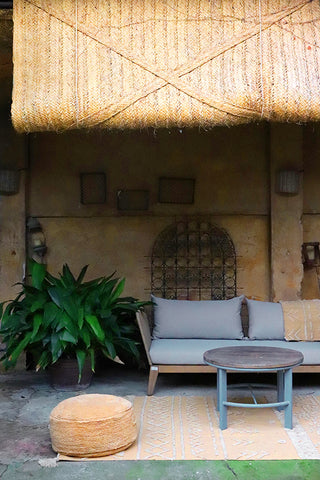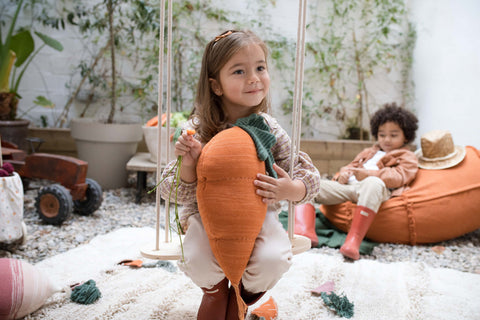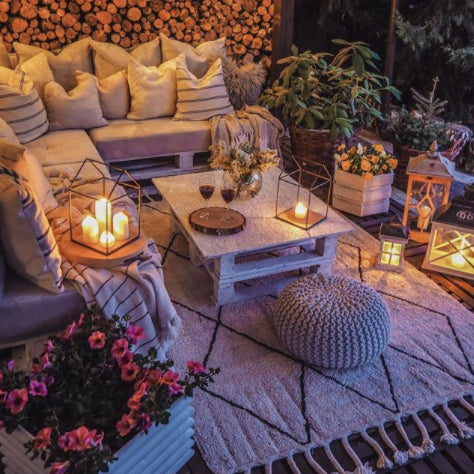Looking to spice up your outdoor living space while also doing your part for the planet? Outdoor rugs has had its own transformation in recent years as technology has evolved around more eco-friendly and sustainable materials for our homes. Recycled PET seems to be the hot item when it comes to outdoor rugs but is recycled plastic really our only option?
Today, we'll explore everything you need to know when shopping for an outdoor rug while being good for the planet.
Look for rugs made from (actually) sustainable materials
The first step in choosing an eco-friendly outdoor rug is to look for rugs made from sustainable materials. What's most popular in recent years are rugs made from recycled PET (polyethylene terephthalate), which is most commonly derived from used plastic beverage bottles that is melted, turned into resin and then spun into yarn.
While recycled PET is a highly affordable and attractive option, the lifespan of a rug made from recycled PET is less than 3 years. At the end of it's life, a rug made from recycled PET is not easy to recycle due to added dyes and chemicals. While the concept of recycled PET outdoor rugs sounds eco, in actuality, it may not be.
Lorena Canals Tribu Honey Cotton Rug
A more eco alternative are rugs made from cotton material. Cotton rugs are mostly machine washable and can be used both inside and outside the home serving a duo purpose. Cotton rugs have a lifespan in upwards of 10 years and at the end of its useful life, it is a material that can biodegrade leaving little to no impact on our environment. Cotton rugs also require fewer resources to produce than traditional synthetic fibres.
Consider the manufacturing process
In addition to the materials used, it's important to consider the manufacturing process of the rug. Look for companies that prioritize sustainability throughout their production chain, from sourcing raw materials to transportation and distribution. Ideally, you want to choose a company that uses eco-friendly practices and has certifications to back up their claims. One particular certification to look for is the B Corp certification that measures a company's entire social and environmental limpact.
Opt for non-toxic rugs
Many synthetic outdoor rugs are treated with chemicals to make them resistant to mold, mildew and fading. Unfortunately, these chemicals can be harmful to both the planet and our health. While not visible to the eye, these chemicals can leech off the rugs when it rains and drains into our sewage system and then eventually our oceans.
Look for rugs that are certified non-toxic, such as those made with natural dyes or those that are untreated altogether. Some certifications that we look for when curating our products include the Global Organic Textile Standard (GOTS), Oeko-Tex and Greenguard certification.
Choose a rug with a long lifespan
The longer a rug lasts, the less impact it has on the environment. Look for outdoor rugs that are durable and designed to withstand harsh weather conditions. Additionally, consider the maintenance requirements of the rug to ensure that it will last for years to come.
Another eco fibre that makes a great outdoor rug is jute. Jute is a natural fibre that is grown without the use of pesticides or fertilizers. It is biodegradable and compostable. While jute is extremely durable and long lasting, it is not washable or moisture proof and therefore, it is not recommended for areas that receive a lot of rain as it would be difficult to dry.
Remember, just because a rug is marked with the words "recycled" on it may not mean it is truly eco friendly. Consider the end-of-life of the rug and choose one that can be easily composted or repurposed. This will ensure that the rug doesn't end up in landfill, where it can harm the environment. By choosing a rug that can be disposed of responsibly, you can further reduce your impact on the planet and create a circular economy for your outdoor decor.
And on that note, go ahead and deck out your outdoor space with eco-friendly flair. And when your friends ask where you got your fabulous rug, you can tell them that it's sustainable, stylish and oh-so-good for the planet!





